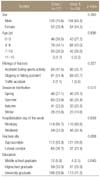Abstract
Purpose
The purpose of this study was to compare the changes in patients pattern retrospectively for pediatric supracondylar and lateral condylar humeral fractures.
Materials and Methods
We retrospectively studied 335 pediatrics treated operatively for supracondylar and lateral condylar fracture from March 1993 to February 2013. The pediatrics were divided depending on the 10-year time period: those who received treatment from March 1993 to February 2003 as group I, and those who received treatment from March 2003 to February 2013 as group II. By each group, the differences in age, gender, cause, season of incidence, whether the time of incidence was a weekend, and education level of the parents were compared and analyzed.
Results
Fractures in group I were mainly due to slip down and fall down, but sports injury was the main cause of fractures in group II. There were 112 cases and 121 cases of supracondylar fractures, and 65 cases and 37 cases of lateral condylar fracture in groups I and II. Significant differences were found in the incidence of lateral condylar facture (p=0.009). In terms of the education level of the parents, the number with high school or under decreased significantly from group I to group II, from 71 cases to 45 cases (p=0.040).
Conclusion
The supracondylar fracture does not show any significant difference according to the time lapse in the age and cause of incidence. However, the incidence of lateral condylar fracture shows a decreasing trend which may be related to the decrease of the incidence of slipping and falling, and the improvement in the parent's education level.
Figures and Tables
References
1. Chan KM, Hung LK, Leung PC. The scene of children's trauma in Hong Kong: a preliminary survey of 3,974 cases in a regional hospital. Bull J Hong Kong Med Assoc. 1984; 36:127–131.
2. Cheng JC, Shen WY. Limb fracture pattern in different pediatric age groups: a study of 3,350 children. J Orthop Trauma. 1993; 7:15–22.
3. Gallagher SS, Finison K, Guyer B, Goodenough S. The incidence of injuries among 87,000 Massachusetts children and adolescents: results of the 1980-81 Statewide Childhood Injury Prevention Program Surveillance System. Am J Public Health. 1984; 74:1340–1347.

4. Izant RJ Jr, Hubay CA. The annual injury of 15,000,000 children: a limited study of childhood accidental injury and death. J Trauma. 1966; 6:65–74.

5. Lenaway DD, Ambler AG, Beaudoin DE. The epidemiology of school-related injuries: new perspectives. Am J Prev Med. 1992; 8:193–198.

7. Mann DC, Rajmaira S. Distribution of physeal and nonphyseal fractures in 2,650 long-bone fractures in children aged 0-16 years. J Pediatr Orthop. 1990; 10:713–716.

8. Worlock P, Stower M. Fracture patterns in Nottingham children. J Pediatr Orthop. 1986; 6:656–660.

9. Farnsworth CL, Silva PD, Mubarak SJ. Etiology of supracondylar humerus fractures. J Pediatr Orthop. 1998; 18:38–42.

10. Scherl SA, Schmidt AH. Pediatric trauma: getting through the night. J Bone Joint Surg Am. 2010; 92:756–764.
11. Alffram PA, Bauer GC. Epidemiology of fractures of the forearm. A biomechanical investigation of bone strength. J Bone Joint Surg Am. 1962; 44:105–114.
13. Park SR, Sohn SK, Park CI, Lee KH. Clinical study on children's fractures. J Korean Orthop Assoc. 1983; 18:297–310.

14. Chung DE, Kim KD, Oh SH. Clinical observation on children's fractures. J Korean Orthop Assoc. 1981; 16:130–139.

15. Blount WP, Schulz I, Cassidy RH. Fractures of the elbow in children. J Am Med Assoc. 1951; 146:699–704.





 PDF
PDF ePub
ePub Citation
Citation Print
Print




 XML Download
XML Download